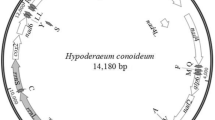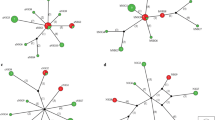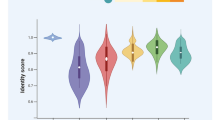Abstract
Prohemistomum vivax is a zoonotic small cyathocotylid trematode that inhabits the intestines of fish-eating birds and mammals. Here, we amplified the internal transcribed spacer (ITS) sequence and six mitochondrial protein-coding genes (PCGs) from P. vivax. The ITS region was 1389 base pairs long and had a partial 18S ribosomal RNA gene, a full ITS1, 5.8S rRNA, and ITS2 sequence, and a partial 28S rRNA gene. The ITS region of P. vivax showed a minimum pairwise distance (0.3–0.6%) from the ITS sequences of Cyathocotylidae sp. 1 and 2 metacercariae from Clarias gariepinus. This result suggests that these metacercariae belong to P. vivax metacercariae. We first amplified mitochondrial genes from P. vivax, including cytochrome c oxidase subunit III (cox3) partial sequence; tRNA-His, cytochrome b (cytb), and NADH dehydrogenase subunit 4L (nad4L) complete sequences; and NADH dehydrogenase subunit 4 (nad4), cytochrome c oxidase I (cox1), and NADH dehydrogenase subunit 5 (nad5) partial sequences. P. vivax was most closely related to Cyathocotyle prussica (NC_039780) and Holostephanus sp. (OP082179), with cox1, cox3, and cytb genes conserved among the three trematodes. The ML phylogenetic tree of ITS sequences supports the order Diplostomida, divided into two main clades (the superfamily Diplostomoidea and Schistosomatoidea). The phylogeny of concatenated amino acid sequences of P. vivax six PCGs revealed that diplostomoids and Clinostomum sp. evolved in a clade with Plagiorchiida members, away from Schistosoma species. These results may yield ribosomal and mitochondrial genetic markers for molecular epidemiological investigations of cyathocotylid intestinal flukes.


Similar content being viewed by others
Data Availability
All relevant data is included within the article. Further inquiries should be sent to the corresponding authors.
References
Abuzeid AM, Hefni MM, Huang Y, He L, Zhuang T, Li G (2022) Immune pathogenesis in pigeons during experimental Prohemistomum vivax infection. Front Vet Sci 9:974698. https://doi.org/10.3389/fvets.2022.974698
Achatz TJ, Pulis EE, Junker K, Binh TT, Snyder SD, Tkach VV (2019) Molecular phylogeny of the Cyathocotylidae (Digenea, Diplostomoidea) necessitates systematic changes and reveals a history of host and environment switches. Zool Scr 48(4):545–556. https://doi.org/10.1111/zsc.12360
Aly S, Eissa I, Badran A, Elamie M, Hussein B (2005) Pathological studies on encysted metacercariae infections among some freshwater fish in Egyptian aquaculture. Duetscher Tropentag, Hohenham University, Stuttgart, Germany
Blasco-Costa I, Locke SA (2017) Life history, systematics and evolution of the Diplostomoidea Poirier, 1886: progress, promises and challenges emerging from molecular studies. Adv Parasitol 98(1):167–225. https://doi.org/10.1016/bs.apar.2017.05.001
Bowles J, McManus DP (1993) Rapid discrimination of Echinococcus species and strains using a polymerase chain reaction-based RFLP method. Mol Biochem Parasitol 57(2):231–239. https://doi.org/10.1016/0166-6851(93)90199-8
Bowles J, Blair D, McManus DP (1995) A molecular phylogeny of the human schistosomes. Mol Phylogenet Evol 4(2):103–9. https://doi.org/10.1006/mpev.1995.1011
Chai J-Y (2019) Miscellaneous zoonotic species. In: Human Intestinal Flukes. Springer Netherlands, Dordrecht, pp 491–520. https://doi.org/10.1007/978-94-024-1704-3_9
Chen L et al (2016) Complete mitochondrial genome analysis of Clinostomum complanatum and its comparison with selected digeneans. Parasitol Res 115(8):3249–3256. https://doi.org/10.1007/s00436-016-5102-6
Chibwana FD (2023) DNA barcoding reveals occurrence of Cardiocephaloides sp. (Digenea: Strigeidae) infecting the great cormorant Phalacrocorax carbo (L. 1758) in Mwanza Gulf, Lake Victoria. Tan J Sci 49(1):96–107 https://doi.org/10.4314/tjs.v49i1.9
Choudhary K, Verma AK, Swaroop S, Agrawal N (2015) A review on the molecular characterization of digenean parasites using molecular markers with special reference to ITS region. Helminthologia 52(3):167–187. https://doi.org/10.1515/helmin-2015-0031
Galazzo DE, Dayanandan S, Marcogliese DJ, McLaughlin JD (2002) Molecular systematics of some North American species of Diplostomum (Digenea) based on rDNA-sequence data and comparisons with European congeners. Can J Zool 80(12):2207–2217. https://doi.org/10.1139/z02-198
Garcia LS (2001) Diagnostic medical parasitology. In: Truant AL (ed) Manual of commercial methods in clinical microbiology, pp 274–305. https://doi.org/10.1128/9781555817961.ch11
Guindon S, Dufayard JF, Lefort V, Anisimova M, Hordijk W, Gascuel O (2010) New algorithms and methods to estimate maximum-likelihood phylogenies: assessing the performance of PhyML 3.0. Syst Biol 59(3):307–21 https://doi.org/10.1093/sysbio/syq010
Hernández-Mena DI, García-Varela M, Pérez-Ponce de Léon G (2017) Filling the gaps in the classification of the Digenea Carus, 1863: systematic position of the Proterodiplostomidae Dubois, 1936 within the superfamily Diplostomoidea Poirier, 1886, inferred from nuclear and mitochondrial DNA sequences. Syst Parasitol 94(8):833–848. https://doi.org/10.1007/s11230-017-9745-1
Kumar S, Stecher G, Li M, Knyaz C, Tamura K (2018) MEGA X: molecular evolutionary genetics analysis across computing platforms. Mol Biol Evol 35(6):1547. https://doi.org/10.1093/molbev/msy096
Landeryou T, Kett SM, Ropiquet A, Wildeboer D, Lawton SP (2020) Characterization of the complete mitochondrial genome of Diplostomum baeri. Parasitol Int 79:102166. https://doi.org/10.1016/j.parint.2020.102166
Liu G-H et al (2014) Dicrocoelium chinensis and Dicrocoelium dendriticum (Trematoda: Digenea) are distinct lancet fluke species based on mitochondrial and nuclear ribosomal DNA sequences. Mol Phylogenet Evol 79:325–331. https://doi.org/10.1016/j.ympev.2014.07.002
Locke SA, Van Dam A, Caffara M, Pinto HA, López-Hernández D, Blanar CA (2018) Validity of the Diplostomoidea and Diplostomida (Digenea, Platyhelminthes) upheld in phylogenomic analysis. Int J Parasitol 48(13):1043–1059. https://doi.org/10.1016/j.ijpara.2018.07.001
Ma J et al (2015) Mitochondrial and nuclear ribosomal DNA dataset supports that Paramphistomum leydeni (Trematoda: Digenea) is a distinct rumen fluke species. Parasit Vectors 8:1–9. https://doi.org/10.1186/s13071-015-0823-4
Ma J, He J-J, Liu G-H, Leontovyč R, Kašný M, Zhu X-Q (2016) Complete mitochondrial genome of the giant liver fluke Fascioloides magna (Digenea: Fasciolidae) and its comparison with selected trematodes. Parasit Vectors 9(1):1–7. https://doi.org/10.1186/s13071-016-1699-7
Nasr M (1941) The occurrence of Prohemistomum vivax (Sonsino, 1892) Azim, 1933. Infection in man, with a redescription of the parasite. Lab Med Prog 2(2):135–149
Philippe H et al (2011) Resolving difficult phylogenetic questions: why more sequences are not enough. PLoS Biol 9(3):e1000602. https://doi.org/10.1371/journal.pbio.1000602
Thaenkham U, Chaisiri K, Hui En Chan A (2022) Molecular Genetic Markers: General Use in Parasitic Helminth Researches Molecular Systematics of Parasitic Helminths, p 161-181. Springer Nature Singapore, Singapore
Funding
This study was funded by the National Natural Science Foundation of China (Grant No. 31672541).
Author information
Authors and Affiliations
Contributions
A.A. and G.L. contributed to the conception and design of the study. A.A., M.H., Y.H., and T.Z. contributed to experiments. A.A. analyzed data and wrote the first draft of the manuscript. G.L. supervised the study and revised the manuscript. All authors read and approved the submitted version.
Corresponding authors
Ethics declarations
Competing interests
The authors declare no competing interests.
Ethics approval
Not applicable.
Consent to participate
Not applicable.
Consent for publication
Not applicable.
Additional information
Section Editor: Christoph Grevelding.
Publisher's Note
Springer Nature remains neutral with regard to jurisdictional claims in published maps and institutional affiliations.
Rights and permissions
Springer Nature or its licensor (e.g. a society or other partner) holds exclusive rights to this article under a publishing agreement with the author(s) or other rightsholder(s); author self-archiving of the accepted manuscript version of this article is solely governed by the terms of such publishing agreement and applicable law.
About this article
Cite this article
Abuzeid, A.M.I., Hefni, M.M., Huang, Y. et al. Phylogenetic relationship of Prohemistomum vivax to other trematodes based on the internal transcribed spacer region and mitochondrial genes. Parasitol Res 123, 113 (2024). https://doi.org/10.1007/s00436-024-08126-z
Received:
Accepted:
Published:
DOI: https://doi.org/10.1007/s00436-024-08126-z




